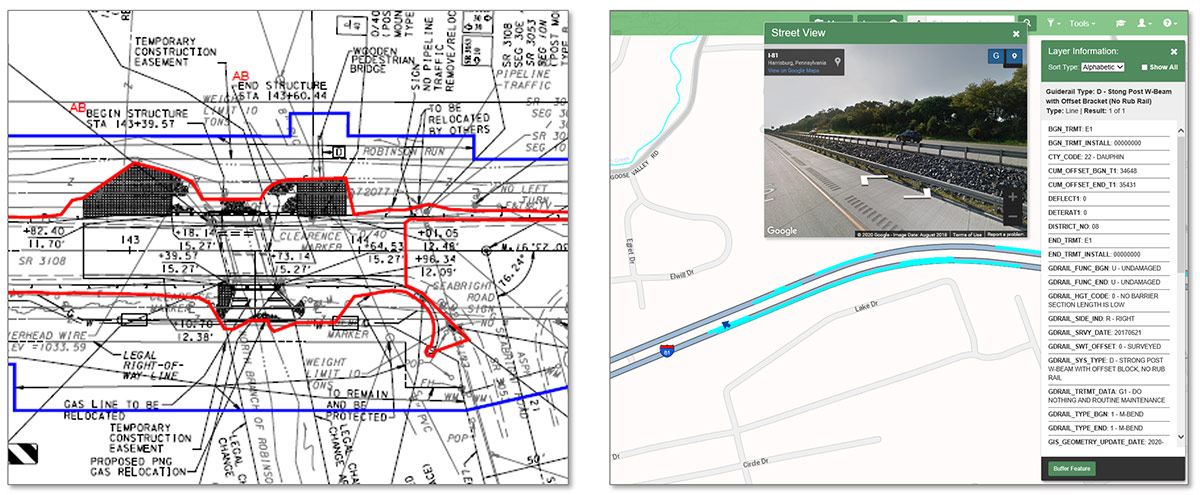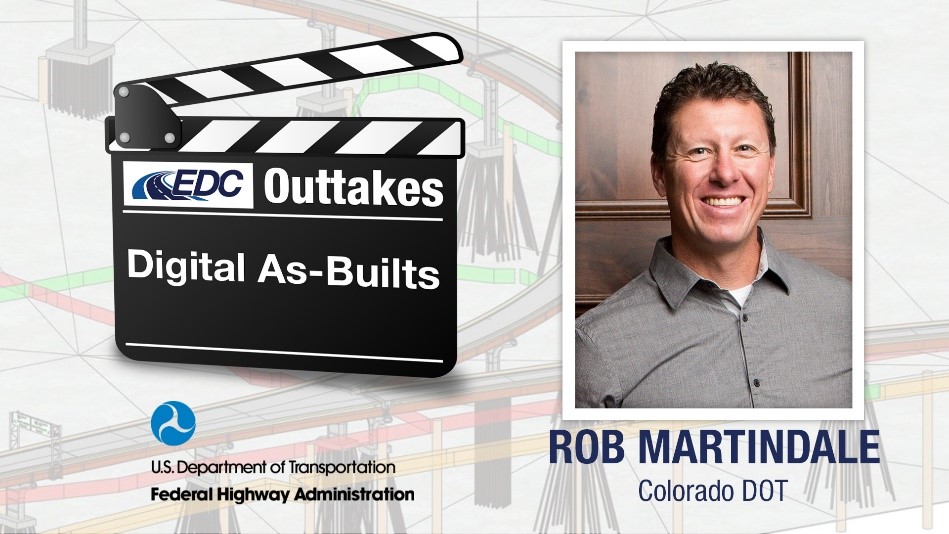November 18, 2021
Innovation of the Month: Digital As-Builts
Agencies are moving to better collect and integrate data during project delivery through digital as-builts (DABs) and effectively pass that information to business needs beyond construction. While the value of these digital practices and digital information is clear, the process to accomplish this is complex. More rapid and strategic success requires buy-in from executive leadership and an implementation plan that breaks down manageable steps to accomplish goals.
PennDOT’s executive leadership has guided development of their ‘Digital Delivery Directive (DDD) 2025,’ understanding the critical needs for driving change management. The DDD includes PennDOT’s step-by-step ‘roadmap’ for implementing foundational digital practices by 2025, including DABs. Deployment will use an agile workflow to implement digital delivery. The agile workflow breaks down digital delivery into narrowly-defined tasks that are tackled in short iterations, called “sprints.” The sprints will be based on discrete use cases for digital data, such as roadway model authoring and construction verification and acceptance. Each year there will be a cycle of defining requirements for use cases, piloting use cases, processing feedback, and documenting successfully tested workflows into new or updated Publications. The roadmap also includes ongoing stakeholder engagement and performance monitoring.

PennDOT’s Vision for the evolution from traditional plans (at left) to Digital As-Builts (at right).
PennDOT is ready to take advantage of the digital delivery process, including improved as-built records. Contractors and construction inspectors will use the digital models on the project site. PennDOT believes the contractors’ as-built deliverable will be an accurate representation of the constructed project and object-oriented data such as 3D models will unify the asset information across the project lifecycle.
The State believes implementing the Directive will provide several benefits. Some of these include reducing risks, project costs and delays by reallocating designers’ time to other tasks; increasing construction efficiency by providing field staff and contractors contract information in a digital format; and improving as-built records as PennDOT reforms the as-built record to digital formats ready for maintenance and asset management business systems.
Watch the e-Ticketing and Digital As-Builts EDC Spotlight video here. To learn more about DABs, please join the team’s e-newsletter or contact David Unkefer, FHWA Resource Center.
A-GaME Techniques Help Alabama DOT Address Landslide Roadway Damage
In 2020, a large landslide occurred on US Highway 231 in Lacey’s Spring, Alabama, causing severe damage to the roadway. This primary route is a heavily used corridor for commuters and the road closure added 30-60 minutes to travel times.
Auburn University conducted seismic profiles and resistivity surveys for the Alabama Department of Transportation to aid in site characterization and develop a designed solution for this emergency roadway section repair. The profile and survey results helped identify stratigraphy and instability across the site. The investigation identified a layer of soft, wet clay overlying rock 30-40 feet below the roadway as a primary slip-plane. Ring shear testing confirmed the subsurface slide plane was very weak and would require a lot of effort, time, and cost to stabilize.
The subsurface characterization contributed to the decision to construct a bridge with a foundational system that could withstand stresses of additional slope movement after removing some of the existing embankment material. The bridge foundations were also instrumented to monitor future movements. Site characterization, design, and construction of the new bridge took approximately seven months to complete.
This project demonstrates how geophysical and geotechnical data can be combined to inform decisions in an emergency response project quickly. To learn more about Advanced Geotechnical Methods in Exploration (A-GaME) techniques, contact Ben Rivers, FHWA Resource Center, or Silas Nichols, FHWA Office of Infrastructure.
City of Austin Supports Pedestrian Hybrid Beacons
City officials in Austin, Texas want to improve pedestrian safety across roadways with high traffic volumes and speeds. The City's Traffic and Pedestrian Signal Request Dashboard allows the public to submit requests for signals such as Pedestrian Hybrid Beacons (PHBs).
Austin installed its first PHB in 2009. Since then, the City has installed more than 55 PHBs and evaluates up to 10 locations each year for possible PHB installation. In addition to public requests, the City enters requests into the system when a master plan or small area plan identifies specific locations for pedestrian crossing improvements, which can be tracked using the City Dashboard.
Researchers from the Texas A&M Transportation Institute studied eight PHB sites in Austin (along with 12 sites in Tucson, Arizona) and published their findings in a Federal Highway Administration Tech Brief. Multiple intersection types were studied, and video data showed drivers yielded between 87 and 98 percent of the time. The average for all 20 sites included in the study was 96 percent.
To learn more about PHBs or other pedestrian countermeasures promoted by the Safe Transportation for Every Pedestrian (STEP) program, contact Becky Crowe with the FHWA Office of Safety or Peter Eun with the FHWA Resource Center.
EDC Outtakes – Digital As-builts

In EDC Outtakes–a series of short interview videos–State practitioners and FHWA personnel give insight into the current round of EDC innovations. In our latest edition, Colorado DOT Utilities Program Manager Rob Martindale explains how digital as-builts benefit a transportation agency.
Keep reading EDC News for future editions of EDC Outtakes!
Stay Up to Date on the EDC Innovations That Interest You Most
EDC teams are always on the move! If you blink, you could miss out on important webinars, case studies, tools, videos, and more. To never miss information for the EDC innovations that interest you most, visit the subscription page and select the topics you’d like to receive updates on directly from the teams that coordinate them.
Recent bulletins:
Local Aid Support – 11/10/21
Local Aid Support – 11/9/21
Virtual Public Involvement – 11/8/21
A-GaME – 11/8/21
NextGen TIM – 11/5/21
STEP – 11/4/21
NextGen TIM – 11/3/21
TOPS – 11/2/21
Browse and Download Information on Hundreds of Homegrown Innovations Featured at 2020 EDC Summit
For the last 9 months, EDC News has showcased the homegrown innovations developed and deployed by State and local agencies across the country. These innovations could help solve challenges in your locality. FHWA has a new resource which summarizes in one document more than 250 innovations highlighted at the summit. Browse or download the innovation document for future reference.
About EDC
Every Day Counts, a state-based initiative of the Federal Highway Administration's Center for Accelerating Innovation, works with state, local and private sector partners to encourage the adoption of proven technologies and innovations to shorten and enhance project delivery.
EDC News is published weekly by the FHWA Center for Accelerating Innovation.
Recommended Citation:
U.S. Department of Transportation, Federal Highway Administration Every Day Counts: Innovation for a Nation on the Move
EDC News: November 18, 2021
Washington, DC:
https://doi.org/10.21949/1521818


